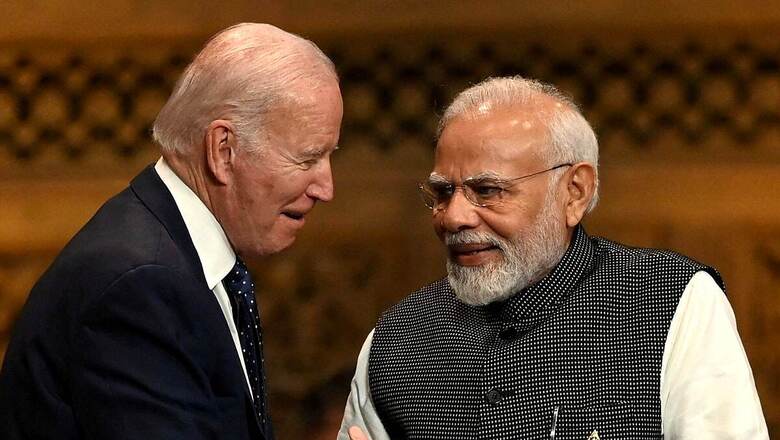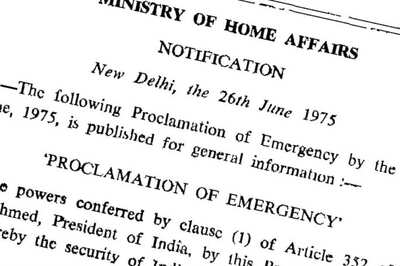
views
A State visit to the US and an address to a joint session of the US Congress by Prime Minister Narendra Modi marks a major advance in India-US ties. India and Modi are being wooed by the Biden administration to an unexpected degree. Ties have no doubt been expanding on many fronts in recent years — defence, economy, people to people — with regular exchanges at the leadership level bilaterally or in multilateral forums. This has given certain political stability to ties despite lobbies in the US that continue to promote negative perceptions of India.
That policymakers and opinion makers outside the government in the US would find a way to balance out their different agendas for India and a deeper strategic partnership with India could be pursued could not be assumed. To what extent policymakers and opinion makers are at different ends of the same spectrum is a different matter, given the working of the US system with its close nexus between different parts of the larger US establishment, with movement from think tanks, business, academia, law firms and even the media to government and vice versa.
India has been under attack ever since PM Modi came to power, and especially during his second term, by the major organs of the US media, the think tank community, India experts, the academic milieu, the human rights organisations, those involved in democracy promotion and religious freedom, and so on. The progressive wing of the Democratic Party has targeted India on minority and religious freedom issues in the US Congress. The US Commission on International Religious Freedom has been traducing India in the way the OIC has been doing, with the same robust and dismissive response from the Indian government.
The State Department has been critical of India in its reports on human rights in India. Unprecedentedly, Secretary Antony Blinken himself commented in March 2023 while releasing the State Department’s annual human rights report that the US was monitoring a “rise of human rights abuses by some government, police and prison officials in India.”
Beyond all this, US criteria, as the world’s foremost power with a natural tendency to dominate, of forging close partnerships with other countries different from that of a country like India with its historical experience of the West, of US policies over decades sought to curb India’s rise, India’s long-standing strategic partnership with Russia and membership of groups formed to promote multipolarity such as BRICS and SCO, not to mention New Delhi’s attachment to strategic autonomy.
The US notion of partnership is one that gravitates towards an alliance or at least a coalition of the willing in military operations, whereas, for India, partnerships can be multiple, even with countries that may be adversarial to each other, if that accords with its legitimate national interest. This is not fence sitting as US international relations experts are inclined to think, but an effort to balance India’s enlightened self-interest and act as a bridge wherever possible. The recommendation by a US Congressional Committee to strengthen NATO Plus consisting of Japan, Australia, New Zealand, South Korea and Israel by including India stems from the US view of what should be a veritable partnership. External Affairs Minister, S Jaishankar has rightly rejected this on the ground that the “NATO template doesn’t apply to India.”
Both India and the US are therefore showing a great deal of pragmatism in coming closer together to meet shared challenges on which their views may not be identical but increased understanding now exists that India needs the US as a partner for its rise and the US sees the need to keep a rising India on its side in the years ahead.
Many positives in India-US ties have already been achieved, which explains the US gesture to the Indian prime minister. India was declared a Major Defence Partner (MDP) of the US, it has signed all the defence-related foundational agreements, the armed forces of the two countries are exercising regularly, the naval Malabar exercises now include both Japan and Australia and have become more complex in scope and are also being held in the western Pacific. India now has a 2+2 (Foreign and Defence ministers) dialogue with the US. India has already acquired over $20 billion worth of American arms.
India is also deepening its commitment to the Quad and fully endorses the Indo-Pacific concept. India and the US have forged two additional Quads in West Asia — the I2U2 comprising India, Isreal, the US and UAE, and the other comprising India, the US, Saudi Arabia and UAE.
During the Ladakh crisis, the US provided intelligence and some high-altitude clothing to India. It has criticised China’s aggressive moves in Ladakh and reiterated its recognition of Arunachal Pradesh as part of India.
If some issues remain on the trade side, the two-way trade in goods and services has reached US $190 billion, making US India’s biggest economic partner. The Ministerial level India-US Commercial Dialogue was held in March 2023.
During US Defence Secretary Lloyd Austin’s recent visit to India, an agreement seems to have been reached on a set of specific proposals that would give India access to cutting-edge US technology. Efforts in this direction have not produced the expected results so far because of the maze of stringent legislative and administrative hurdles that exist in the US system which have proved difficult to navigate. The US has long claimed that India has now the same status as a NATO country in terms of technology transfer. This is not quite true as more agreements need to be signed before India becomes eligible for a real transfer of technology. It has now been decided to start negotiations on the Security of Supply Arrangement and Reciprocal Defence Procurement Agreement.
India had already received Strategic Trade Authorisation tier 1 status in 2018 which would allow it to receive licence-free access to a wide range of military and dual-use technologies. India signed the Industrial Security Annexe in 2019 to allow industry-to-industry cooperation. In May 2023, India and the US held the Inaugural India-US Advanced Domains Defence Dialogue to strengthen partnerships in new defence domains, with emphasis on space and Artificial Intelligence. A new initiative has also been launched by the defence heads called INDUS-X, which stands for enhanced strategic and defence partnership between India and the US.
In May 2022, PM Modi and President Biden had announced the US-India Initiative on Critical and Emerging Technologies to expand the strategic technology partnership and defence-related industrial cooperation between governments, businesses and the academic institutions of the two countries in areas such as AI, quantum computing, 5G/6G, biotech, space, and semi-conductors. Following this, in January 2023, the National Security Advisors of India and the US led the inaugural meeting of the iCET in Washington DC where it was agreed to resolve issues related to regulatory barriers and business and talent mobility through a standing mechanism under the iCET.
In June this year, the inaugural India-US Strategic Trade Dialogue was held in Washington DC which focused on ways in which both governments could facilitate the trade of technologies, in critical domains already identified by reviewing relevant export control regulations, with the objective of building and diversifying resilient supply chains, for which “best practices” on multilateral export control regimes will be shared and industry will be made more aware of these regimes. The US is concerned about leakage to Russia of the technologies it shares with India and has emphasised the need to scrutinise Indian companies that may help Russia in “illicit procurement” and transferring technology for use in the Ukraine conflict. The introduction of the export control element in these technology transfer dialogue risks delaying progress, as intensive discussions and a further change of regulations on our side will be required.
The US government has given clearance to General Electric to develop in cooperation with India with full transfer of technology the GE F414-INS6 jet engine for India’s Tejas Mk II Light Combat Aircraft and AMCA Mk I. This transfer will obviously be in phases with the hot engine technology, which is the core technology — if it is eventually shared — left to the last no doubt. The US Congress is yet to clear the project.
Assuming everything proceeds as expected —there is undoubtedly much more openness on the US side to build technology ties with India — putting together partners, negotiating terms, assessing the economic viability of projects, agreeing on IPRs etc will be a long-haul process. While we are on the right track, we should have a realistic view of the speed at which we can move together.
Kanwal Sibal is a former Indian Foreign Secretary. He was India’s Ambassador to Turkey, Egypt, France and Russia. The views expressed in this article are those of the author and do not represent the stand of this publication.




















Comments
0 comment